
The feet are incredibly complex, intricate parts of the human body, made up of a number of different and important bones. Each bone serves a critical function, including the cuboid bone. One ought to know about this bone because it serves an important role in supporting the arch of the foot and providing stability. As the name of the bone suggests, it is shaped in a kind of cubical structure. This bone is located in the midfoot area and is situated essentially on the outer side of the foot. Being diligent in taking good care of the cuboid bone is essential to maintaining good foot health because if it moves out of alignment, a condition known as cuboid syndrome might develop. This foot affliction can cause a variety of symptoms, most notably a kind of pain on the outer side of the foot. This area of the foot is commonly referred to as the lateral area. For more information about this important bone in the foot, contact your podiatrist.
If you have any concerns about your feet, contact Howard Waxman, DPM from Pleasant Valley Podiatry. Our doctor can provide the care you need to keep you pain-free and on your feet.
Biomechanics in Podiatry
Podiatric biomechanics is a particular sector of specialty podiatry with licensed practitioners who are trained to diagnose and treat conditions affecting the foot, ankle and lower leg. Biomechanics deals with the forces that act against the body, causing an interference with the biological structures. It focuses on the movement of the ankle, the foot and the forces that interact with them.
A History of Biomechanics
Modern technological improvements are based on past theories and therapeutic processes that provide a better understanding of podiatric concepts for biomechanics. Computers can provide accurate information about the forces and patterns of the feet and lower legs.
Understanding biomechanics of the feet can help improve and eliminate pain, stopping further stress to the foot.
If you have any questions please feel free to contact one of our offices located in Willoughby Hills and Broadview Heights, OH . We offer the newest diagnostic and treatment technologies for all your foot and ankle needs.
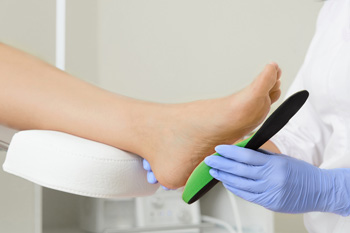
Orthotics are worn inside shoes to correct various structural issues and treat medical conditions. Orthotics can be soft or rigid, both providing similar benefits. Soft orthotics are made with soft materials for extra cushioning. Rigid orthotics are made from harder materials, like carbon fiber or plastic. Orthotics can relieve foot and leg pain. Many symptoms requiring orthotics originate in the lower back and involve nerves that control function and movement in the legs and feet. Conditions causing foot and leg pain include a herniated disc, sleeping in an awkward position, or standing for prolonged times at work. Orthotics allow an individual to be able to maintain the correct alignment of the feet and legs, lessen pain, and prevent it from worsening. Orthotics can also help with managing minor foot deformities, absorbing shock from high-impact exercises, and correcting over-pronation, which is when the arch of the foot collapses inwards. If you think you might benefit from orthotics or want to know more about them, it is suggested that you consult with a podiatrist.
If you are having discomfort in your feet and would like to try orthotics, contact Howard Waxman, DPM from Pleasant Valley Podiatry. Our doctor can provide the care you need to keep you pain-free and on your feet.
What Are Orthotics?
Orthotics are inserts you can place into your shoes to help with a variety of foot problems such as flat feet or foot pain. Orthotics provide relief and comfort for minor foot and heel pain but can’t correct serious biomechanical problems in your feet.
Over-the-Counter Inserts
Orthotics come in a wide variety of over-the-counter inserts that are used to treat foot pain, heel pain, and minor problems. For example, arch supports can be inserted into your shoes to help correct overarched or flat feet, while gel insoles are often used because they provide comfort and relief from foot and heel pain by alleviating pressure.
Prescription Orthotics
If over-the-counter inserts don’t work for you or if you have a more severe foot concern, it is possible to have your podiatrist prescribe custom orthotics. These high-quality inserts are designed to treat problems such as abnormal motion, plantar fasciitis, and severe forms of heel pain. They can even be used to help patients suffering from diabetes by treating foot ulcers and painful calluses and are usually molded to your feet individually, which allows them to provide full support and comfort.
If you are experiencing minor to severe foot or heel pain, it’s recommended to speak with your podiatrist about the possibilities of using orthotics. A podiatrist can determine which type of orthotic is right for you and allow you to take the first steps towards being pain-free.
If you have any questions please contact one of our offices located in Willoughby Hills and Broadview Heights, OH . We offer the newest diagnostic and treatment technologies for all your foot and ankle needs.

Plantar fasciitis is a common injury that can affect the ability to walk, run, and participate in jumping activities. It is a condition that affects the plantar fascia which runs along the sole of the foot. Its function is to connect the toes to the heels, and tears that occur can result in plantar fasciitis. Gradual discomfort eventually progresses to severe pain, and prompt medical treatment is often sought to manage the pain. People that enjoy running and who develop plantar fasciitis often need to limit the number of times they run per week, and this may help to accelerate the healing process. Many patients notice the heel pain is worse in the morning after arising, and performing specific stretches may help to find mild relief. An effective stretch is done by standing on a step, and lowering one heel at a time until a gentle stretch is felt. It is suggested that you consult with a podiatrist at the first hint of heel pain who can properly diagnose and offer correct treatment options.
Plantar fasciitis is a common foot condition that is often caused by a strain injury. If you are experiencing heel pain or symptoms of plantar fasciitis, contact Howard Waxman, DPM from Pleasant Valley Podiatry. Our doctor can provide the care you need to keep you pain-free and on your feet.
What Is Plantar Fasciitis?
Plantar fasciitis is one of the most common causes of heel pain. The plantar fascia is a ligament that connects your heel to the front of your foot. When this ligament becomes inflamed, plantar fasciitis is the result. If you have plantar fasciitis you will have a stabbing pain that usually occurs with your first steps in the morning. As the day progresses and you walk around more, this pain will start to disappear, but it will return after long periods of standing or sitting.
What Causes Plantar Fasciitis?
There are some risk factors that may make you more likely to develop plantar fasciitis compared to others. The condition most commonly affects adults between the ages of 40 and 60. It also tends to affect people who are obese because the extra pounds result in extra stress being placed on the plantar fascia.
Prevention
There are a variety of treatment options available for plantar fasciitis along with the pain that accompanies it. Additionally, physical therapy is a very important component in the treatment process. It is important that you meet with your podiatrist to determine which treatment option is best for you.
If you have any questions, please feel free to contact one of our offices located in Willoughby Hills and Broadview Heights, OH . We offer the newest diagnostic and treatment technologies for all your foot care needs.

An inversion injury happens when the ankle rolls outward while the foot turns inward. This is considered to be the most common type of ankle sprain. Sprains happen as a result of the ankle stretching past its normal range of motion causing immediate pain and discomfort. An eversion injury happens when the opposite occurs, as the ankle rolls inward and the foot rolls outward. The ligaments can become damaged with this type of sprain which can be painful. The least common ankle injury is referred to as a high ankle sprain. This occurs as the ankle moves while the foot remains stable. This can cause the leg to rotate, and often needs prompt medical attention. An ankle sprain can wreak havoc in completing daily activities, and it is strongly advised that if you have incurred this type of injury you consult with a podiatrist as quickly as possible who can provide correct treatment techniques.
Although ankle sprains are common, they aren’t always minor injuries. If you need your ankle injury looked at, contact Howard Waxman, DPM from Pleasant Valley Podiatry. Our doctor can provide the care you need to keep you pain-free and on your feet.
How Does an Ankle Sprain Occur?
Ankle sprains are the result of a tear in the ligaments within the ankle. These injuries may happen when you make a rapid shifting movement while your foot is planted. A less common way to sprain your ankle is when your ankle rolls inward while your foot turns outward.
What Are the Symptoms?
Preventing a Sprain
Treatment of a Sprain
In many cases, the RICE method (Rest, Ice, Compression, and Elevate) is used to treat ankle sprains. However, you should see a podiatrist to see which treatment option would work best with your injury. In severe cases, surgery may be required.
It is important to ask your doctor about rehab options after you receive treatment for your injury. Stretching, strength training, and balance exercises may help the ankle heal while also preventing further injury.
If you have any questions, please feel free to contact one of our offices located in Willoughby Hills and Broadview Heights, OH . We offer the newest diagnostic and treatment technologies for all your foot care needs.
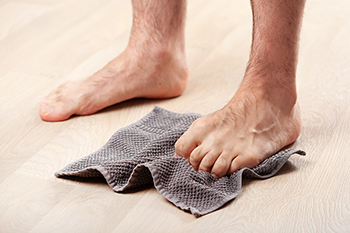
Sometimes due to one’s profession or lifestyle, an individual may be expected to stand for prolonged periods of time without otherwise moving or engaging in physical activities. This static position has its own risks of potential health problems, including lower back pain, foot pain, and achy knees. One way to address the problem of standing in a static position for long periods of time is to stretch because stretching can reduce tension in the muscles. For example, to reduce tension caused from standing, you may choose to perform the standing lunge calf stretch. This can be done by standing in front of a wall, putting one’s hands against the wall, and then repeatedly moving one foot behind the other in a lunge position. You ought to feel a stretch in the calf. This should be repeated on both feet. If you want to learn more about how stretching can address problems caused by standing all day, contact a podiatrist.
Stretching the feet is a great way to prevent injuries. If you have any concerns with your feet consult with Howard Waxman, DPM from Pleasant Valley Podiatry. Our doctor will assess your condition and provide you with quality foot and ankle treatment.
Stretching the Feet
Being the backbone of the body, the feet carry your entire weight and can easily become overexerted, causing cramps and pain. As with any body part, stretching your feet can serve many benefits. From increasing flexibility to even providing some pain relief, be sure to give your feet a stretch from time to time. This is especially important for athletes or anyone performing aerobic exercises, but anyone experiencing foot pain or is on their feet constantly should also engage in this practice.
Great ways to stretch your feet:
Individuals who tend to their feet by regular stretching every day should be able to minimize foot pain and prevent new problems from arising.
If you have any questions, please feel free to contact one of our offices located in Willoughby Hills and Broadview Heights, OH . We offer the newest diagnostic and treatment technologies for all your foot care needs.
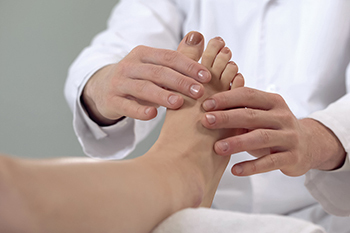
One can get swollen feet from walking or standing for long periods of time. The swelling is often relieved by resting and elevating the feet. Various other things can cause swelling in the feet, such as conditions with bones and tendons, problems with skin and toenails, or drug side effects. However, there are times when the swelling (or edema) is related to a more serious underlying problem like heart failure, developing blood clots, or kidney disease. So this must not be ignored. If you have swelling in your feet and you do not know the cause, or if the swelling worsens, causes pain, or interferes with mobility, contact a podiatrist immediately and have your feet examined. Swelling can be the first clue that something is going on in your body, and a proper diagnosis is imperative for effective treatment.
Swollen feet can be a sign of an underlying condition. If you have any concerns, contact Howard Waxman, DPM of Pleasant Valley Podiatry. Our doctor can provide the care you need to keep you pain-free and on your feet.
Swollen feet are a common ailment among pregnant women and people who stand or sit for extended periods. Aging may increase the possibility of swollen feet and patients who are obese often notice when their feet are swelling too. There may be medical reasons why swollen feet occur:
Swollen feet can also be caused by bone and tendon conditions, including fractures, arthritis, and tendinitis. Additionally, there may be skin and toenail conditions and an infection may cause the feet to swell. Patients who take medicine to treat high blood pressure may be prone to getting swollen feet.
Many patients elevate their feet to help relieve the swelling and this is generally a temporary remedy. When a podiatrist is consulted the reason behind the swelling can be uncovered and subsequently treated.
If you have any questions please feel free to contact one of our offices located in Willoughby Hills and Broadview Heights, OH . We offer the newest diagnostic tools and technology to treat your foot and ankle needs.
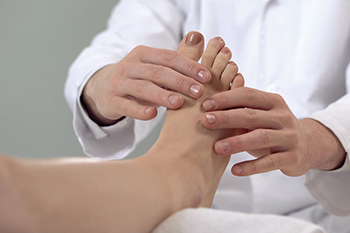
The ankle is one of the most critical parts of the human body because it enables the foot to move upwards and downwards. However, the ankle can be susceptible to painful sensations. For example, ankle avulsion fractures can cause pain in the ankles. This condition occurs when a tendon or ligament is torn and part of a bone is taken with it. Ankle avulsion fractures can feel very similar to ankle sprains, in terms of pain felt and swelling around the affected area. X-rays are usually required to identify ankle avulsion fractures and to distinguish them from regular ankle sprains. Treatment options for those suffering from an ankle avulsion fracture vary widely, depending on the severity of the case. Schedule an appointment with a podiatrist today if you have ankle pain or an ankle avulsion fracture.
Ankle pain can be caused by a number of problems and may be potentially serious. If you have ankle pain, consult with Howard Waxman, DPM from Pleasant Valley Podiatry. Our doctor will assess your condition and provide you with quality foot and ankle treatment.
Ankle pain is any condition that causes pain in the ankle. Due to the fact that the ankle consists of tendons, muscles, bones, and ligaments, ankle pain can come from a number of different conditions.
Causes
The most common causes of ankle pain include:
Symptoms
Symptoms of ankle injury vary based upon the condition. Pain may include general pain and discomfort, swelling, aching, redness, bruising, burning or stabbing sensations, and/or loss of sensation.
Diagnosis
Due to the wide variety of potential causes of ankle pain, podiatrists will utilize a number of different methods to properly diagnose ankle pain. This can include asking for personal and family medical histories and of any recent injuries. Further diagnosis may include sensation tests, a physical examination, and potentially x-rays or other imaging tests.
Treatment
Just as the range of causes varies widely, so do treatments. Some more common treatments are rest, ice packs, keeping pressure off the foot, orthotics and braces, medication for inflammation and pain, and surgery.
If you have any questions, please feel free to contact one of our offices located in Willoughby Hills and Broadview Heights, OH . We offer the newest diagnostic and treatment technologies for all your foot care needs.
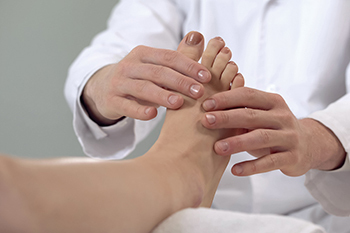
Reflexology is a popular form of foot therapy. It is performed by applying pressure to certain reflex points on the feet which are connected to specific organs. Patients have noticed their ailments may be diminished as a result of having this type of therapy done, and it may produce a healing response in the overall body. Some therapists lightly touch the heels and surrounding areas and may pull on the toes. Having a massage performed is another form of foot therapy. This targets the tissues to relieve tension in the muscles and may possibly improve circulation. The benefits of reflexology can include boosting the immune system, balancing the body’s energy, and reducing toxins in the body. There are additional bonuses for both types of therapies, and if you would like more information, please consult with a podiatrist who can help you to determine which is right for you.
Foot therapy is often necessary for those recovering from either foot deformities or foot injuries. If you have concerns regarding therapy, consult with Howard Waxman, DPM from Pleasant Valley Podiatry. Our doctor can provide the care you need to keep you pain-free and on your feet.
Most Common Injuries
People who are active or athletes are prone to a variety of injuries. Therefore, it is often important to take part in physical therapy in order to quickly get back on the right track.
What to Do When Injured
Physical Therapy – This specialized treatment will focus on the affected area, speeding up recovery and the overall healing process. It is a proven method that has helped millions of people return from any injury.
During physical therapy you will undergo regimented training to get back into full form. Training is often very difficult, especially at first when the foot feels weak. Physical therapy often involves:
Basic stretching and twisting exercises – getting the feet’s mobility and flexibility up.
Massaging – the therapist will massage the injured area in order to activate the muscles and relax them.
Strengthening Exercises – this allows the muscles in the affected area to regain their full strength, a vital step towards full recovery.
If you have any questions please feel free to contact one of our offices located in Willoughby Hills and Broadview Heights, OH . We offer the newest diagnostic tools and technology to treat your foot and ankle needs.